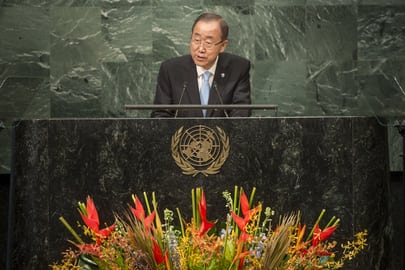
NEW YORK — The Paris Agreement on climate change on Wednesday reached one of its thresholds for entry into force, as the number of ratifying states hit 60.
During an early morning special meeting of the United Nations General Assembly, representatives from 31 nations presented to U.N. Secretary General Ban Ki-moon instruments of ratification for the global accord. The Paris Agreement will enter into force 30 days after 55 nations representing at least 55 percent of global greenhouse gas emissions have formally ratified the agreement.
Going into the event, 29 nations representing 40.12 percent of global emissions had submitted their instruments of ratification. The countries that ratified the agreement Wednesday represent another 7.5 percent, bringing the total to 60 nations covering 47.76 percent of global emissions.
Tuesday, United Kingdom Prime Minister Theresa May in her first address to the U.N. stated that the nation will join the Paris Agreement by the end of the year. “We will continue to play our part in the international effort against climate change. And in a demonstration of our commitment to the agreement reached in Paris, the UK will start its domestic procedures to enable ratification of the Paris agreement, and complete these before the end of the year,” she said. The U.K. is responsible for 1.55 percent of global emissions.
“I am confident that by the time I leave office this year, the Paris Agreement will have entered into force,” Ban said during the event.
The nations that joined the agreement Wednesday are: Albania, Antigua and Barbuda, Argentina, Bangladesh, Belarus, Brazil, Brunei Darussalam, Dominica, Ghana, Guinea, Honduras, Iceland, Kiribati, Madagascar, Mexico, Mongolia, Morocco, Namibia, Niger, Panama, Senegal, Singapore, the Solomon Islands, Sri Lanka, Swaziland, Thailand, Tonga, Uganda, the United Arab Emirates, and Vanuatu.
Entry into force of the Paris Agreement, which develops a framework for nations to pursue domestically developed climate mitigation and adaptation actions, is a three-step process. Nearly 200 nations adopted the deal in December at the 21st session of the Conference of the Parties (COP21) to the United Nations Framework Convention on Climate Change (UNFCCC). At U.N. headquarters in New York on April 22, 175 nations then signed the accord. Now those governments need to ratify the agreement.
Ukraine, representing 1.04 percent of global emissions, submitted its document one day before the event. At the time it was the No. 3 top emitter to ratify, behind China and the United States. In addition, several nations signed the agreement this week in New York: Armenia, Chile, Malawi, Togo, and Zambia.
Watch for expanded coverage of the event in Thursday morning’s GHG Daily.